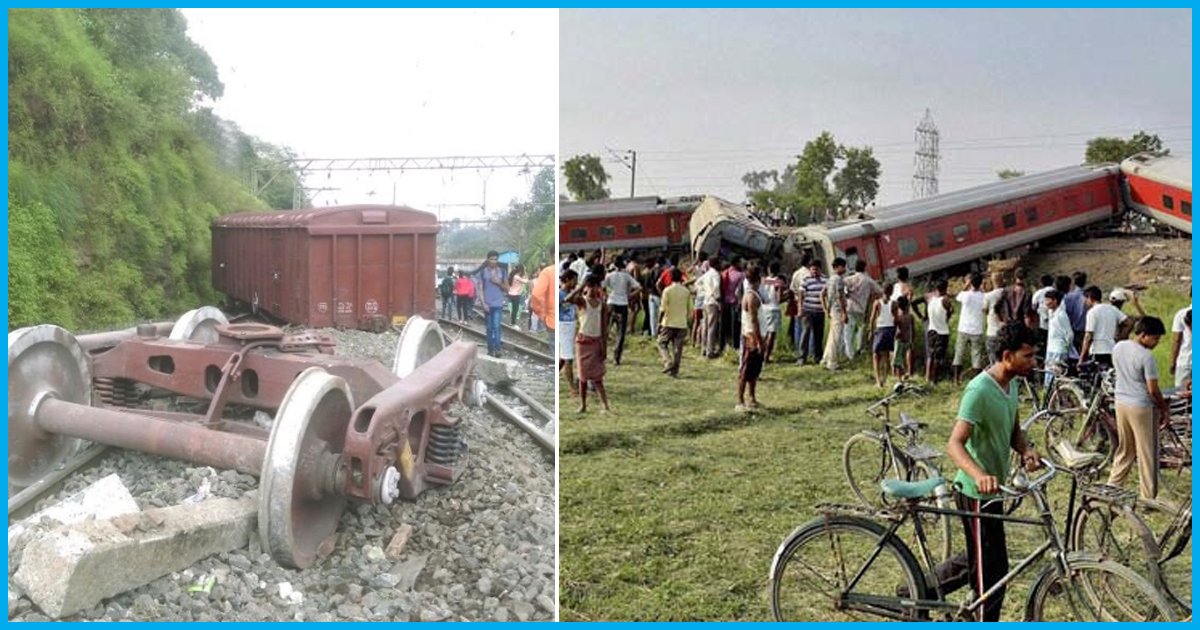
3 Train Derailments In Less Than 10 Hours: Why Are India’s Trains Going Off Tracks?
8 Sep 2017 12:34 PM GMT
Editor : Pooja Chaudhuri
The only fiction I enjoy is in books and movies.
Yesterday, September 7, three trains derailed within the span of less than 10 hours.
The first derailment took place in the morning at 6:25 am when 7 coaches of the Jabalpur-bound Shaktipunj Express went off the tracks near the Obra Dam station in Uttar Pradesh’s Sonbhadra district.
This was the third derailment in UP. On August 19, at least 23 people were killed and around 400 injured after 14 coaches of the Puri-Haridwar Utkal Express derailed at Khatauli, near Muzaffarnagar, Uttar Pradesh; on August 23, 74 people were injured after 8 coaches of the Kaifiyat Express derailed and one overturned in Auraiya in Uttar Pradesh.
Four hours after the Shaktipunj Express derailment, at around 11:45 pm, one coach and one engine of the Ranchi-Delhi Rajdhani Express derailed near Shivaji Bridge station in Delhi.
Engine and Power car of Ranchi Rajdhani Express derail on Delhi's Shivaji Bridge. No injuries reported
— ANI (@ANI) September 7, 2017
At 3:45 pm on Thursday, another derailment occurred. This time, two wagons of a goods train derailed near Khandala, Maharashtra.
Another accident was averted minutes before Kalindi Express was scheduled to pass after locals spotted a fracture in the tracks. The derailment was a near miss on a track between Farrukhabad and Fatehgarh in UP.
Why are India’s trains going off tracks?
The main reason for the increasing number of accidents is the huge gap between government’s promises and the ground reality.
Indian Railways commutes more than 23 million people in its 12,000 trains a day. It is one of the oldest networks in the world, thus making regular maintenance essential. However, our tracks are neglected and overburdened.
The Economic Times reports that out of the 64,000 km track, 7,000 km tracks is over 30 km old and needs immediate replacement.
Derailments mainly occur due to faulty tracks – rail fractures, corrosion and lack of maintenance.
Corrosion is possible even on 1-2 year old tracks and they need to be maintained regularly. The fracturing of tracks, often caused by the expansion of tracks in summer and contraction in winter, is another threat to trains. In 2015, the Railway Ministry had said some 4,500 km track should be renewed every year, however, only 2,100 km of the track were targeted for renewal.
Last month, five new trains were flagged off by former Railway Minister Suresh Prabhu. The government continues to announce new trains even though tracks don’t have the required infrastructure to endure the burden.
Besides this, nearly 40,000 coaches need to be replaced, 80 bridges need to be rebuilt and 5,000 unmanned level crossings need to be removed.
At the root of the problems is the financial crunch faced by Indian Railways with insufficient investments in the safety of passengers.
Contradictory government data
On August 22, the rail ministry said that the number of train accidents in the last three years have been on a decline after it initiated a series of safety measures.
However, according to government data, there were 117 accidents in 2013-14 which increased to 131 in 2014-15; and the number of deaths in each financial year was 42 and 118 respectively – an increase by almost three times.
Furthermore, in its Rajya Sabha reply on August 11, the ministry of railways said that there have been 104 accidents in 2016-17 but the number of deaths increased to 238.
There is a discrepancy in the government’s own data because the Indian railways website says that 118 people died in 2015-16, however, rail ministry said that the number of deaths in 2015-16 was 122.
Preventive measures
The World Bank in a recent report found that the current system of accident investigations by the Commission of Railway Safety (CRS) was inadequate and strongly recommended that an independent rail safety regulatory authority and investigator be set up in the country to prevent accidents.
It suggested an array of other measures including the installation of ditch lights, high-visibility clothes for Railway employees, training of current investigators, etc.
The Logical Indian take
In spite of claims by the Railway Ministry, train derailments never cease to occur. One can say without a doubt that the ministry seems to have lost the sense of accountability and there is absolutely no value for the lives which are lost.
In the first five months of this year, a total of 29 serious train accidents has occurred, out of which 20 accidents happened due to the derailment. Last year, 78 derailments took place on railway tracks two of which were attributed to ‘coach defect.’ In the last five years, between 2012-13 and 2016-17, 308 accidents occurred due to derailment, out of the total 586. Out of total 1,011 casualties, 347 were killed due to train derailments and 449 because of unmanned level crossings.
Only in November last year, 14 coaches of the Patna-bound Indore-Rajendranagar Express train derailed between Pokhrayan and Malasa stations in Uttar Pradesh, killing 152 passengers and injuring 183.
But the Railway authorities have hardly learnt from past mistakes. Most accidents are met with oft-repeated reactions like strictest action shall be taken against the guilty. Days pass, inquiry commissions submits reports to assess which accident has had the most damaging effect, unless another case of derailment again makes it to the headlines.
The Logical Indian community urges the government to bring in changes in the infrastructure, in terms of betterment of tracks so that such cases of derailment does not occur on such a frequent basis. Lakhs of passengers travel on trains every day and nothing justifies negligence on part of railway authorities.
 All section
All section













